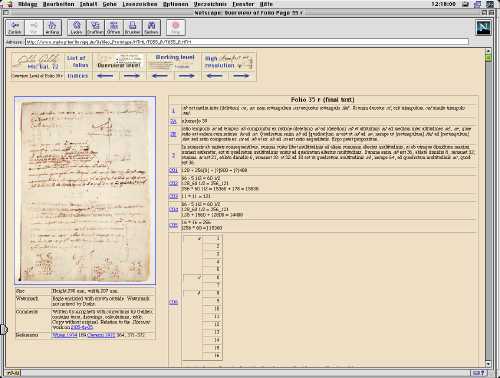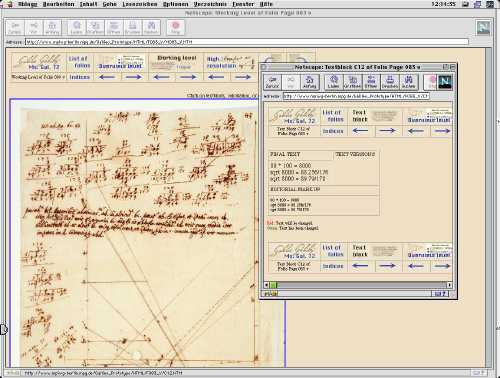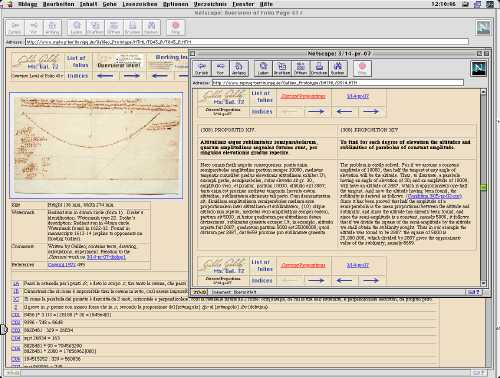Galileo at Work:
His Complete Notes on Motion in an Electronic Representation
Peter Damerow and Jürgen Renn
Max Planck Institute for the History of Science
(to appear in
Nuncius
)
Galileo Digitale
As a result of a joint project of the Biblioteca Nazionale Centrale, the Istituto e Museo di Storia della Scienza, both in Florence, and the Max Planck Institute for the History of Science in Berlin, an electronic representation of Galileo's notes on motion and mechanics including a working environment for historians of science has recently been made available through the internet:
- http://galileo.imss.firenze.it/ms72/index.html
- http://www.mpiwg-berlin.mpg.de/Galileo_Prototype/MAIN.HTM
The electronic representation was officially presented and made accessible to the public on the occasion of an international meeting under the title "Galileo Digitale" in May of this year. It represents a manuscript that has a tremendous importance for the study of the transition from Aristotelian to classical physics. The manuscript consists of about 200 loose sheets of papers which contain Galileo's notes on his discoveries in mechanics. The notes were taken over a time period of about 30 years, beginning with his early work on mechanics in Padua around 1600 and ending with the work on his final publication, the Discorsi , written in the 1630ies when he was arrested in Arcetri. In spite of its importance, this manuscript, preserved as part of Codex 72 in the collection of Galileo's manuscripts at the Biblioteca Nazionale, has neither been translated in full, nor even been adequately published until today. The electronic representation of Galileo's notes on motion as it is now available presents this historical document, together with the results of research on it, in a new way, it offers new tools for further research, and it is expected to become a backbone for a collaborative research effort on this important manuscript in the future.
The need for a fresh approach to Galileo's manuscripts
It is virtually impossible to publish the chaotic mixture of texts, calculations and drawings on the pages of Codex 72 using traditional editorial techniques. Even the masterful Edizione Nazionale (1890-1909) of Galileo's papers by Antonio Favaro, which is the canonical entry point to Galileo's work, proved to be insufficient in its representation of this codex. In the edition one finds, in particular, only transcriptions of texts of a certain minimal length; the calculations have been omitted completely and frequently also the diagrams contained in the codex. Another difficulty of this traditional edition lies in the disposition of the fragments which follows a certain (sometimes questionable) logic and which is not based on their placement in the pages of the codex. The same difficulty is characteristic also of a supplement to the Annali di Storia della Scienza (1979, Fasc. 2) which contains Galileo`s Notes on Motion Arranged in Probable Order of Composition and Presented in Reduced Facsimile" by Stillman Drake, but, to stick to the truth, thus presented in a piece-meal way cut into fragments according to the alleged order. In view of the steadily growing scholarly interest in Galileo's manuscripts, the project of a new and comprehensive edition of the Codex 72 hence became a desideratum.
But what yesterday was a nightmare, has now become the favorite challenge of the prophets of the information age and even received a seductive label: hypertext. The intricate structure of Galileo`s scribbled notes is modest compared with what today is modelled by computer programmers. Now Stillman Drake could have saved his labor to cut the facsimile reproductions of the manuscript pages literally into pieces. Tools for realizing hypertexts have dissolved all the obstacles of tackling a chaotic manuscript such as Galileo`s notes on motion so that it became possible to represent the folio pages of the original in a way that complex semantic networks can be traced and bold hypothesized connections can be elaborated by simple mouse clicks.
The electronic representation of the manuscript Codex 72, as it is now available as a hypertext , is the outcome of a pilot project directed by Isabella Truci (Biblioteca Nazionale), Paolo Galluzzi (Istituto e Museo di Storia della Scienza), and Jürgen Renn (Max Planck Institute for the History of Science). The project is part of a larger endeavor by the Biblioteca Nazionale in Florence and the Istituto e Museo di Storia della Scienza to make the Florentine Galileo collection electronically accessible. The Biblioteca Nazionale provided the digital images of the manuscript, generously gave the permission for their inclusion in the electronic representation, and contributed in many other ways to the realization of the pilot project. A working group at the Max Planck Institute for the History of Science created the electronic working environment in which the electronic representation of the codex is embedded. The scholarly work on the codex that is included as part of the electronic representation was performed by a common working group of the Istituto e Museo di Storia della Scienza and the Max Planck Institute for the History of Science.
There are two elements which characterize the outcome, the electronic representation of the manuscript: easy access and open-endedness. The first element can easily be explained: since the manuscript is accessible through the Internet, no scholar is forced anymore to first apply for a travel grant to go to Florence in order to study it. The second element is, however, really new and requires some further explanation.
Some characteristic features of the electronic representation
The electronic representation of a manuscript is a new form of edition which substantially differs from a traditional paper copy edition. It has its own editorial and technical principles. While this is not the place to provide an explanation of these principles in detail, we nevertheless want to illustrate the different character of the electronic representation of Codex 72 by mentioning a few outstanding features.
The electronic representation comprises the following main components:
- information about the history of the manuscript,
- short descriptions of the contents of the folios and the relations to the Discorsi ,
- images of the folio pages in different resolutions,
- transcriptions of the texts including corrected and cancelled versions,
- translations of calculations into modern notation,
- reproduction of drawings,
- information on paper sizes, water marks, handwriting, and scholarly work on specific folio pages (to be extended in the future),
- separate indices for Italian and Latin words, for numbers, for designations of variables, and for the lettering of drawings,
- Discorsi theorems with proofs in the original language and in English translation, as well as the results of an analysis of their deductive structure.
There are three principal modes of accessing the manuscript: The folio pages can either be reached via a list of folio pages, via the indices, or the Discorsi propositions to which they are related.
Each folio page is represented on four levels of representation . These levels can be accessed through bars at the top and the bottom of the page representing a carefully designed navigation system that guides the user in a self-explanatory fashion through the complex structure of the electronic representation. At the so-called "overview level" the user finds a reduced facsimile, together with a transcription of the "final text," i.e. the text remaining after all corrections, deletions, and additions found on the folio page. In addition, the overview offers general information on the folio page such as its size, its watermark, its content, the relevant bibliographical references, and an indication of the relation of the content of the page to the Discorsi . The "working level" displays a well-readable facsimile of the folio page, which, at the same time, serves as a "map" with clickable areas corresponding to the text blocks, calculations, and drawings on that page. On this level, the facsimiles can be rotated in order to facilitate reading of entries written in different directions. The level of the "high resolution image" offers the best available facsimile of the given folio page. A fourth level with full transcriptions of individual text blocks, reconstructions of calculations, and reproductions of drawings can be accessed via links on the overview level and on the working level.

(Click to enlarge the picture - 190 kB)
In an electronic representation, the transcriptions serve a purpose that is somewhat different from their role in a traditional edition. In fact, digital images make it unnecessary to use a sophisticated technique of representing details of the original texts in the form of writing-conventions as they are used in paper editions. Consequently, the transcription is mainly intended as a reading aid, focussing on making explicit the reading in cases such as deletions where neither the digital images nor even the original manuscript allow for an immediate recognition of the text. The transcriptions serve, of course, also as the basis for automatic searching procedures, another feature that cannot be realized in a paper edition.

(Click to enlarge the picture - 140 kB)
The electronic form of reproducing the manuscript offers indeed far-reaching opportunities of handling the data that are extensively exploited in our edition of Galileo's notes on motion. Thus, internal links between related pages of the chaotically numbered folios facilitate the comprehension of internal consistencies and developments of Galileo's thought. Links to other sources, publications, and scholarly work, though still incomplete, provide entry points to the current research on the pages of the manuscript. One of the most attractive modes of access that is entirely unparalleled by traditional editions is provided by the automatically generated indices of words, numbers, of the lettering of drawings, as well as by the list of propositions.
These indices can be used for a great variety of research purposes. The list of propositions, for example, makes it possible to quickly identify all manuscripts containing notes related to a particular proposition of Galileo's Discorsi . In this way, the electronic representation incorporates information as one would expect it from a critical edition of the Discorsi. The index of words allows, for instance, to trace the usage of particular concepts in Galileo`s research, such as the concept of impetus. The indices of numbers and of the lettering of drawings, rather unusual from the perspective of a normal" edition, may provide a researcher with important clues as to the relation between notes on different manuscript pages - an extremely helpful tool for working on a codex consisting of a mixed-up bundle of loose sheets.

(Click to enlarge the picture - 190 kB)
Behind the stage: a glimpse at the genesis of an electronic representation
Not only the use of an electronic representation but also the way in which it is produced distinguishes it fundamentally from a traditional edition on paper. Such a traditional edition is usually the result of the work of a small number of editors. The quality of the edition entirely depends on their qualification and on the research they invest while working on that edition. When their work is finished, it is up to the publisher to realize an adequate format of its representation on paper. Once the book is printed there is no longer any possibility of improving the edition except by starting all over again and producing a new edition.
This is quite different in the case of the electronic representation of Galileo's manuscript described here. First of all, the institutions involved had to substantially support the project in order to provide the wide range of information included in this representation and to provide the material preconditions of representing them electronically. The electronic representation consists of more than 20,000 files which, of course, cannot be written individually but have to be created by computer programs. Specially designed electronic working environments have been used also for the preparation of the input data, e.g. in order to link the scanned images to the transcription of the text or to link the text of theorems of the Discorsi to individual folio pages. In contrast to traditional editions, the technical work was intimately linked to the studies of the content of Galileo's manuscript involving a couple of enthusiastic collaborators with a wide range of competencies. Some persons who contributed to the success of this endeavor should at least be named apart from the ones mentioned already above. In an addition to the authors of this report, it were primarily Jochen Büttner and Simone Rieger who took the main burden of realizing the idea of an electronic representation of Galileo`s notes on motion. Michele Camerota transcribed the texts of the manuscript. Bernd Wischnewski wrote the majority of the programs for the electronic data processing, supported by Jörg Kantel who added, in particular, the JAVA programming. Carmen and Martin Warnke designed the navigation system.
Since its begininng the work on the electronic representation was also an adventure in new forms of scientific cooperation starting with just a vision. The story began some ten years ago when one of the contributing institutions, the Max Planck Institute for the History of Science, did not even exist. At about that time the authors of the present report discussed with Paolo Galluzzi, director of the Istituto e Museo di Storia della Scienza, the future of the access to sources in the history of science and the opportunities opened up by the rapidly developing computer technology. On that occasion the idea was born that it might be possible to combine the introduction of the new media for information storage and retrieval with a revolution of the scholarly work of historians of science. The Science and Technology Studies Program of the US National Science Foundation, then directed by Ron Overmann, funded a feasibility study which provided crucial information for our later work. A "Galileo Einstein Electronic Archives Project" was designed with the goal of providing a model for future projects by digitizing two major archives important for the understanding of the history of modern science. These archives essentially were unexploited because of the difficulties of traditional possibilities of accessing large corpora of sources. Based on the reports of the reviewers of the project, the NSF was ready to fund a great part of the main project for digitizing the archives. Reviewers for NSF concluded, however, that the idea of intimately linking the digitalization project with the development of tools for innovations in scholarly work on historical sources was unrealistic.
What was even more discouraging, also a substantial component of the less ambitious part of the "Galileo Einstein Electronic Archives Project," the digitalization of the Einstein Archives, could not be realized, in spite of the fact that agencies from various countries guaranteed the funding. It was instead decided that the right of first publication of all unpublished items in the archives of ca. 55 000 documents should remain with the traditional paper edition which even at that time was planned to be finished not before the middle of the second decade of the new millenium.
It was the support of the Max Planck Society and, above all, of Italian institutions at all levels that kept alife the vision of combining technical innovation with scholarly work. What has now been made publicly available to scholars is precisely the most ambitious part of the originally planned project.
A tool for the future
It is this most ambitious part which fundamentally distinguishes the electronic representation from any traditional paper edition: the electronic representation is not the once and forever given quintessence of past scholarly work but a powerful working environment for future research. The product is not final in the sense that it cannot be changed any longer, but rather a starting point for a new era of scholarly work on the manuscript. The new form of accessibility will broaden the scope of cooperating persons to virtually all scholars of the world interested in this manuscript and the results of their work can then be integrated into the updated versions.
In fact, once all the input information is provided, the production of a new version of the electronic representation needs not longer than 15 minutes and does not cause any additional costs. In contrast to the time and cost necessary for producing a paper edition highlights the essential qualitative difference which turns an edition as an end in itself into an edition which is the potential starting point for further cooperative research. We hope in fact that the further development of this electronic representation will be a truly joint result achieved together with those colleagues with whom, up until now, collaboration has been limited to publications in the same journals or in collections of essays dedicated to Galileo.